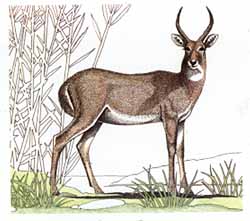English: Southern Reedbuck; French: Cobe des roseaux; Afrikaans: Rietbok; Gbaya: Kòk-tè; Maasai: Enkijipuruk; Kikuyu: kihare, Muciri; Kirundi: Insasu; Kiswahili: Tohe; Nganguela: Ntava; Punu: Kombo; Shangan: Nhlangu; Shona: Bimba; Sindebele: Mziki; Xhosa: Umjiki; Zulu: Inxala, Inhlangu
 |
Former distribution: As now.
Present distribution: Angola, not in the south-western areas; Zambia, Malawi, western and southern Tanzania, Mozambique, northern Namibia, northern Botswana, in South Africa in Transvaal, Orange Free State, Natal, Transkei and eastern Cape Province.
Behaviour: Preferred habitat: tall grasses or reedbeds near water. They are not typically gregarious, living singly or in pairs, and forming small family herds. Their activity is diurnal and at twilight: they graze on grass and the tender shoots of reeds. Predators include leopards, wild dogs, hyenas, lions, cheetahs and crocodiles.
Population status: Stable. Estimated number: no records.
Brief notes:
Body weight: 75-95 kg
Head and body length: 145-170 cm
Tail length: 25-30 cm
Shoulder height: 85-105 cm
Gestation period: 7 3/4 months
Maximum age: 10 years
Trophy: Record SCI: 52 3/8 score, 1984 Zimbabwe, DAVID L. HUNSICKER; average 34 score. RW’s: 183 3/8″. 1983 Natal RSA, ERWIN ROHRS; average 13 1/2″. CIC: 107.45 points, 1951 Zambia, GROVT; average 100 points.
Hunting methods: Stalking with trackers.
Subspecies: 2
1. Redunca a. arundinum Malawi, southern Zaire south to the Cape Province in RSA. Stable.
2. Redunca a. occidentalis From Sudan, Kenya, Tanzania, eastern Zaire to northern Zambia. Stable.
Remarks: Female reedbucks carry no horns.





